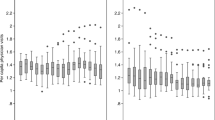Abstract
The aim of this article is to identify those factors which produce differences in the use of public health care services among individuals whose medical needs are similar. The empirical analysis employs Spanish data for three separate years and obtains results for four types of medical attention: visits to a GP, visits to a specialist, visits to the emergency services and hospital inpatient days. The results show that the influence of demand factors upon the probability of consuming more medical attention than expected depends on the type of health care considered.In addition, the minimal impact of supply factors is demonstrated.
Similar content being viewed by others
REFERENCES
D.P. Forster, Social class differences in sickness and GP consultations, Health Trends 8(1976) 29–32.
J. LeGrand, The distribution of public expenditure: the case of health care, Economica 45(1978) 125–142.
M. Blaxter, Equity and consultation rates in general practice, British Medical Journal288 (1984) 1963–1967.
E. Collins and R. Klein, Equity and the NHS: self-reported morbidity, access andprimary care, British Medical Journal 281 (1980) 1111–1115.
A. Wagstaff, E. van Doorslaer and P. Paci, Equity in the finance and delivery of health care: some tentative cross-country comparisons, Oxford Review of Economic Policy 5(1) (1989) 89–112.
F. Rutten, E. van Doorslaer and A. Wagstaff, eds., Equity in theFinance and Delivery of Health Care: An International Perspective (Oxford University Press, 1993).
A. Wagstaff and E. van Doorslaer, Measuring and testing for inequity in the delivery of health care, The Journal of Human Resources 35(4) (2000) 716–733.
U.G. Gerdtham, Equity in health care utilization: further tests based on hurdlemodels and Swedish micro data, Health Economics 6 (1997) 303–319.
A.J. Culyer, Need, equity andequality in health and health care, Discussion Paper 95, Centre for Health Economics, University of York.
A.C. Cameron, F. Milne, P.K. Trivedi and J. Piggot, A microeconometric model of the demand for health care andhealth insurance in Australia, The Review of Economic Studies 181 (1988) 85–106.
W. Pohlmeier and V. Ulrich, An econometric model of the two-part decision-making process in the demand for health care, The Journal of Human Resources 30 (1995) 339–361.
Ministerio de Sanidad y Consumo, Encuesta Nacional de Salud deEspaña 1987 (Madrid, 1989).
Ministerio de Sanidad y Consumo, Encuesta Nacional de Salud de España 1993(Madrid, 1995).
Ministerio de Sanidad y Consumo, Encuesta Nacional de Salud de España 1995 (Madrid, 1997).
G.S. Maddala, Limited-Dependent and Qualitative Variables in Econometrics (Cambridge University Press, 1983).
W.H. Greene, Econometric Analysis, 3rd Ed. (Prentice-Hall, 1997).
A.C. Cameron and P.K. Trivedi,Regression-based tests for overdispersion in the Poissonmodel, Journal of Econometrics 46 (1990) 347–364.
A.C. Cameron and P.K. Trivedi, Econometric models based on count data: comparisons and applications of someestimators and tests, Journal of Applied Econometrics 1 (1986) 29–53.
J. Mullahy, Specification andtesting of some modified count data models, Journal of Econometrics 33 (1986) 341–365.
J.T. Groggerand R.T. Carson, Models for truncated counts, Journal of Applied Econometrics 6 (1991) 225–238.
J.P. Acton, Nonmonetary factors in the demand for medical care: some empirical evidence, Journal of PoliticalEconomy 93 (1985) 595–614.
Ministerio de Sanidad y Consumo, Desigualdades sociales en salud en España(Madrid, 1996).
Ministerio de Sanidad y Consumo, Catálogo Nacional de Hospitales 1989 (Madrid, 1989).
Ministerio de Sanidad y Consumo, Catálogo Nacional de Hospitales 31/12/1993 (Madrid, 1994).
Ministerio deSanidad y Consumo, Catálogo Nacional de Hospitales 31/12/1995 (Madrid, 1996).
B. Alvarez, La demandaatendida de consultas médicas y servicios urgentes en España, Investigaciones Económicas (2001), forthcoming.
M. Grossman, A stock approach to the demand for health, in: The Demand for Health: A Theoretical and EmpiricalInvestigation (NBER, Columbia University Press, 1972).
J. Muurinen and J. LeGrand, The economic analysis ofinequalities in health, Social Science and Medicine 29 (1985) 1029–1035.
A. Williams, The nature,meaning and measurement of health and illness: an economic viewpoint, Social Science and Medicine 20 (1985) 1023–1027.
M. Ben-Akiva and S.R. Lerman, Discrete Choice Analysis: Theory and Application to Travel Demand(MIT Press, Cambridge, MA, 1985).
I. Abásolo, R. Manning and A. Jones, Equity in utilisation and access topublic sector GPs in Spain, Applied Economics (2000), forthcoming.
Author information
Authors and Affiliations
Rights and permissions
About this article
Cite this article
Urbanos-Garrido, R.M. Explaining Inequality in the Use of Public Health Care Services: Evidence from Spain. Health Care Management Science 4, 143–157 (2001). https://doi.org/10.1023/A:1011461728666
Issue Date:
DOI: https://doi.org/10.1023/A:1011461728666




